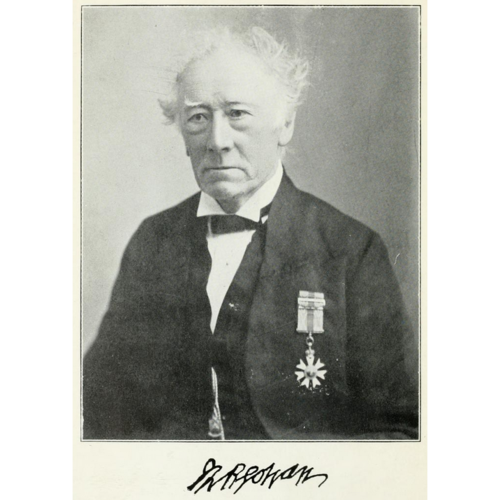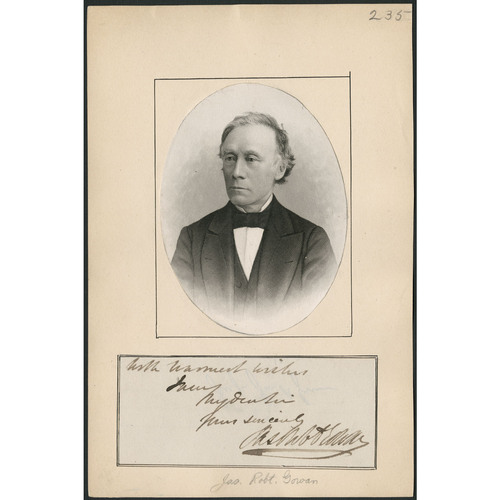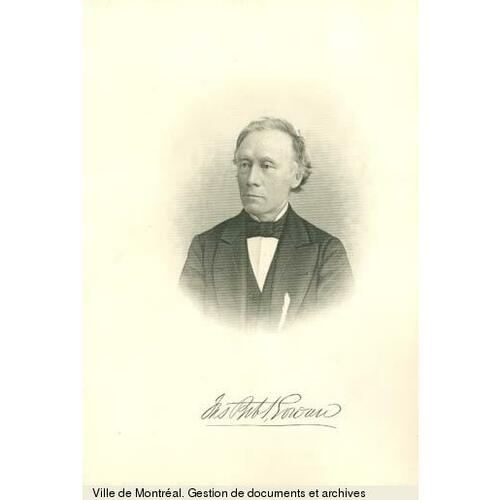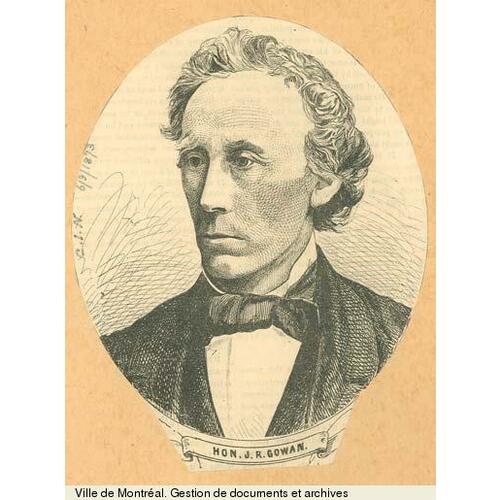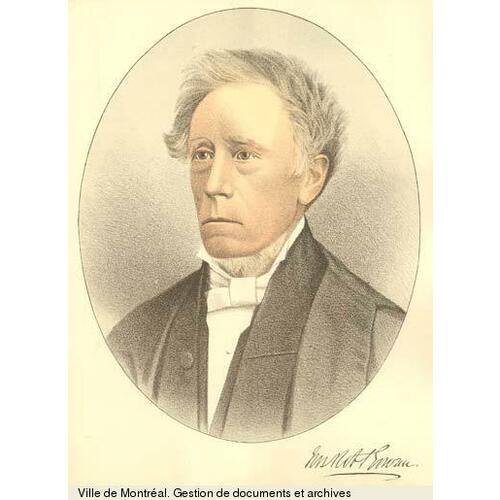As part of the funding agreement between the Dictionary of Canadian Biography and the Canadian Museum of History, we invite readers to take part in a short survey.
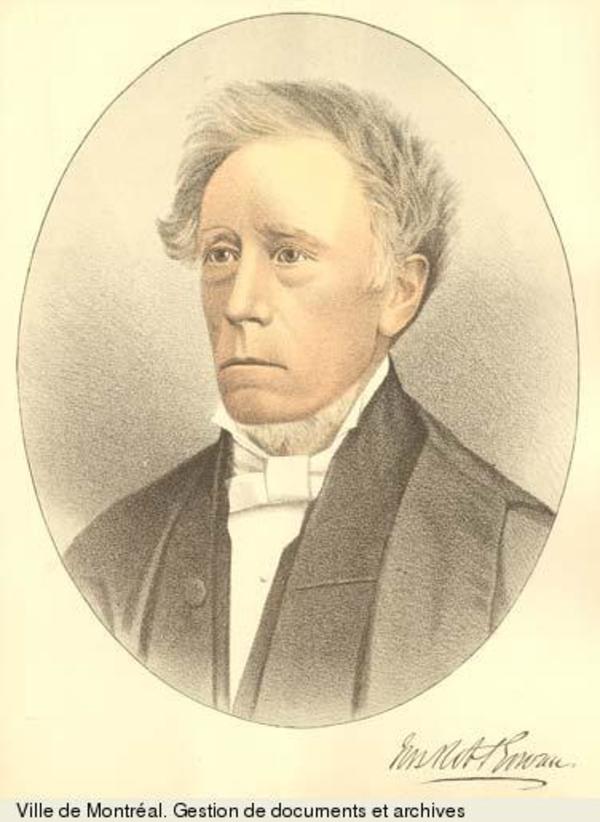
Source: Link
GOWAN, Sir JAMES ROBERT, lawyer, judge, and senator; b. 22 Dec. 1815 in Cahore, County Wexford (Republic of Ireland), third and only surviving son of Henry Hatton Gowan and Elizabeth Burkitt; m. 7 July 1853 Anne Ardagh in Shanty Bay, Upper Canada; they had no children; d. 18 March 1909 in Barrie, Ont.
Born into the tory, Anglican squirearchy of southern Ireland and raised on the family estate at Cahore, James Robert Gowan was educated privately in Dublin. In 1832 the family joined the stream of Anglo-Irish emigration to the Canadas begun by the enactment of the Catholic Emancipation Bill. They arrived at York (Toronto) in the autumn of that year, settling in Albion Township, in what is now Peel County. In December 1833 James became a student in the law office of James Edward Small* and a boarder in his home at York. He was an extremely able pupil and Small, who was elected to the Legislative Assembly in October 1834, increasingly left much of the burden of the practice to Gowan while he pursued his political career.
Small was a moderate reformer, but Gowan did not at this time look to the reformers for advancement. His family was tory, and his first political activity was in support of that cause. In 1835 his older cousin Ogle Robert Gowan*, grand master of the Orange lodge, who was looking to regain his seat in the assembly, asked James to procure in Toronto clear titles to land for his supporters in Leeds County, so that they could be enfranchised. James, who had become a member of the lodge soon after his arrival in Upper Canada, was pleased to oblige. (At the same time he had an affair with Ogle’s wife, of which Ogle was unaware.) He further displayed his tory loyalty by joining the York militia at the outbreak of the rebellion of 1837–38, during which he fought in the skirmish at Gallows Hill, north of Toronto. Later he revived a dormant Orange lodge (No.210) and helped fight off an attempt to unseat his cousin as grand master. By 1838 he had earned Ogle’s approbation, promotion to grand secretary of the Orange order, and considerable political influence among the Anglo-Irish community in Upper Canada.
In 1839 Gowan completed his articles with Small, and joined him in partnership. He was called to the bar that year. Though Small was no longer an mla, Gowan still did most of the routine work. He also helped defend many of the rebels of 1837–38. Early biographers assert that this experience caused him to change his political allegiance, and it may have had some bearing on his actions. It is more probable, however, that he sensed a shift in the political wind in favour of the reformers, a shift that was manifested by Small’s re-election in 1839 and by a resurgence of public support for the reformers. In any case, Gowan campaigned for Small that year and for both Small and reform leader Robert Baldwin* in by-elections in 1841 and 1842. He severed his association with the Orange lodge, long a bastion of toryism, and made repeated attempts to retrieve his correspondence with Ogle. His political opportunism paid off. Small became solicitor general for Upper Canada in the La Fontaine*–Baldwin administration of 1842–43. In gratitude, and with a little prompting from Gowan, Small nominated him for the judgeship of the newly created Simcoe District. Appointed on Baldwin’s recommendation at the age of 27 in January 1843, he became the youngest judge ever commissioned in the British empire to that time.
Gowan had his work cut out for him. Simcoe was the largest jurisdiction in Upper Canada, and it eventually extended from the Holland River south of Lake Simcoe north to the French River. Before Gowan’s appointment, judges of Queen’s Bench, riding quarterly circuits, heard cases where the value of the action was between 40s. and £40. Lesser claims were decided in district courts composed of justices of the peace. The justices also had jurisdiction in criminal cases and, with the grand jury in quarter sessions, constituted the local government in their area. As the first permanent judge, who would preside in both the district and the division courts, and as chairman of quarter sessions, Gowan had to set up the judicial system, appoint the necessary court officers, and organize and ride circuits. He also had to contend with the hostility of tory jps, for they had lost their civil jurisdiction to him and their administrative role, with its large patronage power, to the newly constituted district council, whose warden, Jacob Æmilius Irving, was a Baldwin appointee and much influenced by Gowan. Soon after moving to Barrie, the district seat, Gowan became involved in educational affairs as well, serving as a trustee of the town’s grammar school (1843–93), chairman of the district board of public instruction (1844–71), and chairman of the local high-school board and then of the collegiate institute board, from which he resigned in 1892.
A prodigious worker, Gowan was entirely successful in dealing with the judicial problems confronting him. In large part his success can be attributed to a formidable personality and an intimidating familiarity with the legislation that reorganized the courts and provided for district councils in Upper Canada after the union of the Canadas in 1841. Prior to his appointment he had begun to make himself useful to Baldwin by drafting legislation. This activity did not stop after his elevation to the bench, because he had decided views on the composition and function of lower courts, local government, and a host of other concerns. Secure in his judicial tenure, he continued to offer advice and drafts of proposed legislation not only to Baldwin, but also to succeeding heads of government, regardless of their political stripe, who thanked the willing worker and saddled him with new tasks.
Typical in this respect, and the first of many similar commissions to come his way, was his appointment in 1853 to a board of district judges which was to recommend improvements in lower courts and to consolidate the legislation concerning jps. Later that year the commission produced the Division Courts Extension Act and three acts pertaining to the functions of jps. The drafting of the legislation was attributed to Gowan by William Buell Richards*, an attorney general in the reform government of Francis Hincks* and Augustin-Norbert Morin*. This was the work that caught the eye of John A. Macdonald*, the conservative attorney general for Upper Canada in the succeeding coalition administration, and led to a long and fruitful friendship.
Effective as Gowan’s methods were, they were slow and piecemeal, and he evidently thought he could do more to shape legislation if he could reach a wider audience. His solution produced a singularly effective technique for manipulating opinion and lobbying for change. Having prospered financially, he undertook in 1855 to underwrite the publication of the first legal periodical in the colony, the Upper Canada Law Journal, which survives today as the Canadian Bar Review. He supplied the cash for start-up and hired an editor with whom, in effect, he had made a secret agreement. The judge was to supply all the editorials, major articles, and published correspondence in the Journal, and “no matter [Gowan] object[ed] to [was] to appear therein, but his connection with the same was not to be revealed.” It was an odd transaction, but one typical of Gowan, who thought that accomplishing reform was more important than getting credit for it. Having created his forum, he put it to good use almost immediately.
As a judge, Gowan objected to being forced into the role of prosecutor also, when a private individual laid a charge but did not hire a lawyer to argue it. He wrote a series of editorials in the Journal publicizing the problem, and offered as a solution the employment of permanent, salaried prosecutors. At the same time, he wrote to Macdonald, quoting the editorials and suggesting that legislation be introduced in line with their recommendations. The articles had obviously caused favourable comment in the legal fraternity, and such a system would solve many vexing administrative problems for the attorney general. Macdonald asked Gowan to send him a draft bill, which was enacted by the Legislative Assembly in the session of 1857 as the Upper Canada County Attorneys Act. In this way Upper Canada became the first jurisdiction in the British empire to abandon the arrangement whereby the victim of crime was required to pay the cost of prosecution, and to introduce a system in which a salaried law officer prosecuted accused persons. It later became the model for similar systems in the provinces of the dominion. Using variations of this approach in the Journal, Gowan was responsible for sowing the initial seed of much subsequent legislation and nurturing its growth, and for opposing initiatives and concepts he did not agree with. One of the measures he disliked was the Jury Bill of 1861, which would have allowed a majority of jurors to decide disputes in civil suits; Gowan was for unanimity.
Gowan’s methods ensured that his views prevailed or, at least, were carefully considered in the drafting of legislation he saw as vital to his interests. He also exercised considerable influence on the administration of the law. Although he was a prolific writer and note taker and produced a number of indexes to the statutes of Upper Canada, he never authored a major publication. What he did do was select a series of junior members of the bar, some of them editors of the Journal, to act as literary front men. He supplied them with notes and copies of his speeches, and followed the writing process closely. When proof-sheets were supplied, he read and revised every page. On at least one occasion he provided funds to publish a work. In this way several legal texts first saw the light of day, including James Patton’s Canadian constables’ assistant (1852), Robert Alexander Harrison*’s Common Law Procedure Act (1858) and New municipal manual (1859), William Fuller Alves Boys’s Practical treatise on the office and duties of coroners (1864), Henry O’Brien’s Division Court’s Act, rules and forms (1866), John Alexander Gemmill’s Bills of divorce (1889), and John Alexander Kains’s How say you? (1893), a book on the deficiencies of the grand jury. The lawyer got the credit and Gowan had his ideas put before the public in a way that allowed him to promote them with apparently disinterested zeal. In the process he also established a series of debts among young men on the rise, which could be called in on suitable occasions in the future.
During the 1850s Gowan entered the most productive period of his public service. Extracurricular tasks, in addition to education, now began to occupy more of his time than judicial duties. In 1856 a commission was struck to consolidate the law of the Province of Canada and of its two sections. Appointed a member by Macdonald two years later, Gowan drafted a large number of the statutes for both the Upper Canadian and the provincial volumes. As a disciple of British legal theorist Jeremy Bentham, he had, over the years, urged the attorney general to follow Bentham’s injunction to codify the law. Macdonald had also read Bentham and had discussed codification with the judge. In fact, his ultimate aim was codification, but he was a pragmatic politician. His immediate aim was to condense the enacted law of more than half a century into a handy format for administrators and practitioners, not to debate its substantive detail in the legislature. The government therefore proceeded with consolidation, publishing the Consolidated statutes of Canada and the companion volume for Upper Canada in 1859; the volume for Lower Canada appeared two years later. Yet, these volumes were unlike any previous collections of statutes in the Canadas, and they resembled codes rather than traditional consolidations. Each was arranged in a topical format with a table of contents, a comprehensive index, and an apparatus of titles, chapters, and marginal notes similar to those used in the Nova Scotia and New Brunswick codes of 1851 and 1854 respectively. Even though Gowan had advocated codification privately, he himself would have supported any measure that reduced the number of statutes and brought order to the remainder. Consequently, his editorials in the Journal followed the practical line laid down by Macdonald. “In the abstract [codification] is perfection. In practice it is an absurdity,” Gowan wrote in 1859. “And yet we admit that some of the merits of consolidation are its approximation to codification.”
In 1869, after confederation, Macdonald asked Gowan to assist in drafting the criminal law of the dominion. Again Gowan urged codification and again the prime minister put him off with promises, insisting on an amended form of English statutes in order to avoid a potentially long and acrimonious debate over which variant of colonial criminal law should be adopted.
With the rising tide of immigration and the growing industrialization of Upper Canada in the middle years of the century, the workload for district judges grew onerous. As a result, there was agitation for a raise in judicial salaries and for assistance to reduce the load of the bench. In effect, Gowan acted as mediator between Macdonald and the judges in these matters. Initially he exercised a restraining influence on his brethren, but because the attorney general continued to procrastinate, Gowan grew testy and took the judges’ side. Macdonald, alerted to the fact that time was running out, resolved the problems before an open breach occurred. Gowan himself carried on without aid in his judicial district until 1869, when his brother-in-law, John Anderson Ardagh, was appointed deputy county judge for Simcoe.
In most of his initiatives Gowan had been able to keep out of the public eye, but in two instances he stepped into the spotlight. During the tenure of the coalition government which was negotiating confederation, a smouldering dispute over costs between the Department of Public Works and the contractors for the Parliament Buildings in Ottawa flared into life. As a result, it was announced in 1864 that a committee would be struck to arbitrate the dispute. The Macdonald–Cartier* ministry had authorized construction in 1859, and it was the opinion of Reformers in the coalition cabinet that any committee appointed by Macdonald would be biased in favour of the contractors, who were known Conservative supporters such as Thomas McGreevy*. There was thus the potential to wreck the coalition, if the scenario predicted by the Reformers ran its course. The committee was to be composed of three members: one nominated by the department, one by the contractors, and one by the government. Macdonald pleaded with Gowan to join; he did so, reluctantly, and was elected chairman. In the event, the members proceeded without rancour or serious disagreement, a small award was made to the contractors (far less than had been demanded), and the process was seen to be impartial, even by the Reform opposition. In essence, so too was the report of the judicial commission that investigated the Pacific Scandal of 1873 [see Lucius Seth Huntington*], although its members were roasted in the Liberal press during the investigation. Gowan had accepted a place on the commission, along with Charles Dewey Day* and Antoine Polette*, only after repeated urging by Macdonald, now prime minister. Though there is no doubt that the commissioners were selected by the cabinet as persons who would “do us justice” or that Gowan personally would have supported the government’s cause if the evidence had been in its favour, there is equally no doubt that they were impartial in their proceedings and report. They expressed no judicial opinion: their function was “expurgatory and inquisitorial” only, their hearings were public, and they made it ostentatiously clear that “their intercourse with [the prime minister] and other members of the gov’t was to cease pending enquiry.” Questions on the constitutionality of the commission, as well as its evidence, nevertheless fuelled an escalating attack on the government, which was forced to resign in November 1873.
Gowan’s talents were by no means monopolized by the prime minister. In 1869 John Sandfield Macdonald*, the Reform premier of Ontario, appointed him chairman of the Board of County Judges, which position he held until 1887. The board kept the rules for the province’s lower courts under constant review and acted as the appellate tribunal for all conflicting decisions in the division courts. Gowan drafted the Speedy Trials Act for Sandfield, which was enacted by the dominion in 1869 and originally applied to Ontario and Quebec. He also did much of the work on a bill for the fusion of common law and equity, a cut-down version of which was enacted as the Administration of Justice Act in 1873 by Oliver Mowat’s Liberal government. The judge became a personal friend of Mowat, and in 1876 the premier appointed him a member of the commission that produced the Revised statutes of Ontario in 1877. After Sir John A. Macdonald had been turned out of office in Ottawa, Gowan had focused his attention on the attorney general in Alexander Mackenzie*’s Liberal administration, Edward Blake*, who began to work towards codification of the criminal law. He offered his services to Blake in this endeavour and urged him to press the process to completion. Unfortunately, Blake left the justice portfolio in 1877 and the initiative petered out. Gowan then began a correspondence with Henri-Elzéar Taschereau*, author of several books on criminal law and newly promoted to the Supreme Court of Canada by the outgoing Mackenzie administration. Gowan suggested that Taschereau, in view of his familiarity with the subject, would be the most qualified person to draft a criminal code and again he offered his assistance and the use of the documents he had collected for such an enterprise. Taschereau was interested, but, as he was not a favourite of Macdonald’s new government, he did not proceed with the project at that time. In 1889, however, he took up Gowan’s suggestion and presented Attorney General Sir John Sparrow David Thompson* with an oral proposal for a criminal code. Ultimately, it was this proposal that galvanized the attorney general to cause the enactment of the Criminal Code of 1892.
For his many services, Gowan was offered promotion to senior benches on several occasions. There is little doubt that he would have been a success in any such position, since in his long tenure as a judge only two of his decisions were reversed on appeal. But he refused all offers. He was content with his relatively obscure position in Barrie, from which he was able to exercise profound influence.
In 1883, at the age of 67 and after 40 years on the bench, Gowan resigned. Loath to lose his services, Macdonald prevailed on him to accept appointment to the Senate, on 29 Jan. 1885. As a senator, Gowan defied the conventional image of a superannuated party hack dozing away his days in the upper chamber. Within weeks of his first attendance he had become a member of three standing committees and of several special committees, and he was chairman of half the divorce committees convened that session (since confederation divorce bills originated in the Senate). He assisted the Department of Justice in drafting innumerable measures, ranging from a franchise bill to a revision of the Summary Jurisdiction Act of 1869; he wrote the rules for divorce which were used in the Senate until the 1960s; and he chaired the divorce committee from 1888 to 1905. During the passage of the Criminal Code in 1891–92, he bombarded the attorney general with advice and suggested amendments. Thompson invariably used the latter, but ignored the former since Gowan, by that time, had amply demonstrated his inability as a parliamentary tactician; in the case of the Criminal Code, he almost caused the legislation to come to grief because of an inappropriately timed and worded speech in the Senate. Gowan gave his colleagues in government additional cause for concern by his support for D’Alton McCarthy* and the linguistic program of the Equal Rights Association. Not only did he give McCarthy financial support to win re-election to the commons in 1891, in Simcoe North, but he also pressed for McCarthy’s appointment to cabinet: first to Macdonald’s and then to those of John Joseph Caldwell Abbott* and Thompson.
Gowan overtly gave his allegiance to the Conservative party after his retirement from the bench, but he never achieved a position of influence in the party hierarchy. By both temperament and upbringing, he was too independently minded to be a good party man, and certain autocratic tendencies had been strengthened by his long tenure on the bench. Although he was an unparalleled source of information on past events and was without peer as a legislative draftsman, whose advice continued to be solicited by attorneys general, he must often have infuriated the cabinet by his self-governed actions. When he said in the course of a debate that senators were independent thinkers, he was defining his own position. As such he was a failure as a party politician, because he would not follow the Conservative line if he did not agree with it, and he pursued his own legislative goals whether or not they coincided with party policy.
Despite his refusal of senior judicial appointment, Gowan valued the many plaudits that came his way and he accepted a number of honours. In 1884 he received an lld from Queen’s College, Kingston (where in 1899 he would be responsible for founding and, in large part, endowing the Sir John A. Macdonald chair of political and economic science). He was made a qc in 1889, in which year he was also called to the Irish bar. Created a cmg in 1893 and knighted in 1905, just days after the death of his wife, he retired from the Senate two years later. Sir James Robert Gowan died at the age of 94 at Ardraven, his home in Barrie. In his 40 years on the bench and his 22 years in the Senate, Gowan exercised more influence over legislation and the lives of Canadians than most elected politicians.
[A primary source for any study of law in Upper Canada, Ontario, and the dominion in the 19th century, the Gowan papers in the NA (MG 27, I, E17) cover the period 1835–1909. There are also sizeable numbers of Gowan’s letters and draft legislation in the Macdonald papers (NA, MG 26, A) and the Sir John S. D. Thompson papers (NA, MG 26, D). However, there is no trace of his membership in the Orange order or of his considerable correspondence with Ogle R. Gowan on this subject in any of these collections. His connections with the order can be found in the James and Ogle Gowan papers in the AO (F 28), which also holds the Small and Gowan papers (F 1293).
Although they contain a good deal of basic information, The Hon. James R. Gowan, member of Canadian senate: a memoir, edited by Arthur Hugh Urquhart Colquhoun (Toronto, 1894), and Henry Hatton Ardagh’s Life of Hon. Sir James Robert Gowan . . . (Toronto, 1911) are hagiographies in the worst 19th-century tradition: Gowan without warts. A useful corrective is Mark Winston Fisher’s ma thesis, “Sir James Robert Gowan: a pioneer judge” (Univ. of N.B., Fredericton, 1971), a scholarly and readable account which repairs several deficiencies, but which still leaves many questions unanswered. Donald Harman Akenson touches on the seamy side of James’s relationship with Ogle Gowan’s family in The Orangeman: the life & times of Ogle Gowan (Toronto, 1986). Marvin R. Bloos makes a close study of Gowan’s use of the Upper Canada Law Journal (Barrie, Ont.; Toronto) in “The crown prosecutor in Alberta: an unfinished hybrid” (ll.m. thesis, Univ. of Alta, Edmonton, 1987). For details of his impact on criminal law see my study, The genesis of the Canadian Criminal Code of 1892 ([Toronto], 1989). d.h.b.]
Cite This Article
Desmond H. Brown, “GOWAN, Sir JAMES ROBERT,” in Dictionary of Canadian Biography, vol. 13, University of Toronto/Université Laval, 2003–, accessed March 29, 2025, https://www.biographi.ca/en/bio/gowan_james_robert_13E.html.
The citation above shows the format for footnotes and endnotes according to the Chicago manual of style (16th edition). Information to be used in other citation formats:
| Permalink: | https://www.biographi.ca/en/bio/gowan_james_robert_13E.html |
| Author of Article: | Desmond H. Brown |
| Title of Article: | GOWAN, Sir JAMES ROBERT |
| Publication Name: | Dictionary of Canadian Biography, vol. 13 |
| Publisher: | University of Toronto/Université Laval |
| Year of revision: | 1994 |
| Access Date: | March 29, 2025 |


